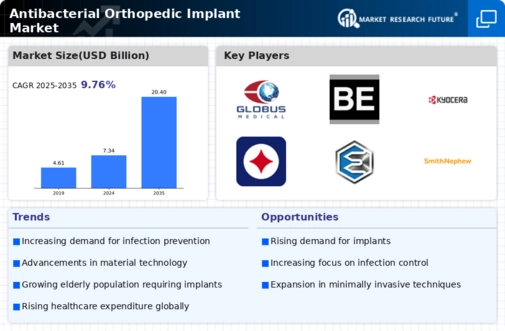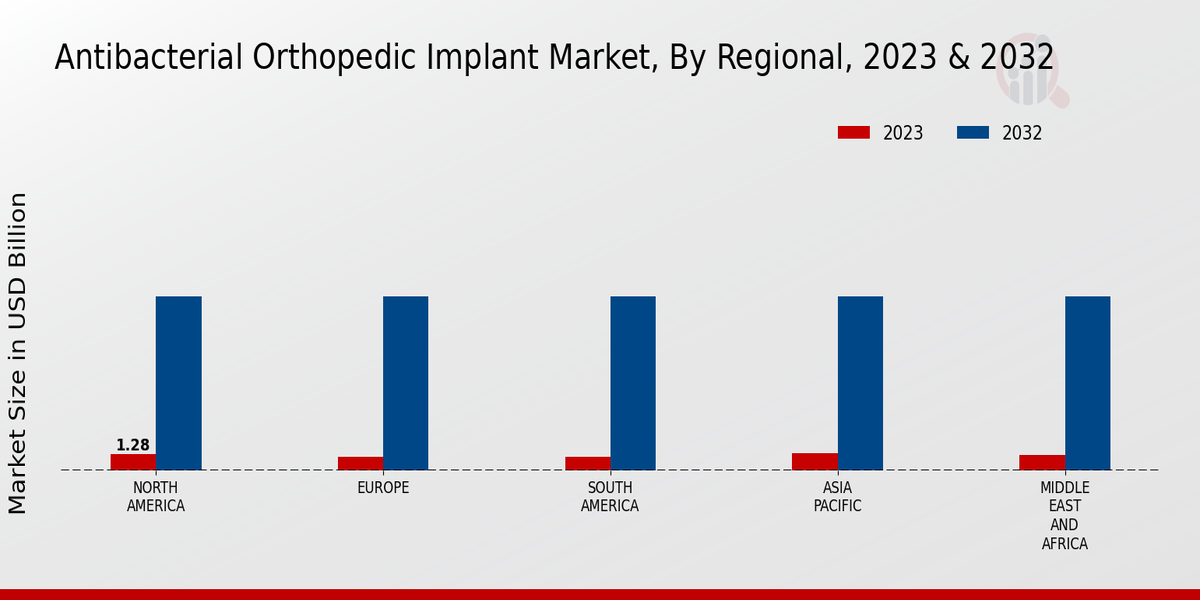Market Growth Projections
The Global Antibacterial Orthopedic Implant Market Industry is poised for substantial growth, with projections indicating a market value of 7.34 USD Billion in 2024 and an anticipated increase to 20.4 USD Billion by 2035. This growth trajectory reflects a compound annual growth rate (CAGR) of 9.76% from 2025 to 2035. Such figures underscore the rising demand for innovative solutions in orthopedic care, driven by factors such as increasing surgical procedures, technological advancements, and heightened awareness of infection control. The market's expansion is indicative of a broader trend towards improving patient outcomes and reducing healthcare costs associated with orthopedic infections.
Growing Geriatric Population
The aging population worldwide is a crucial factor propelling the Global Antibacterial Orthopedic Implant Market Industry. Older adults are more susceptible to bone-related disorders and require orthopedic interventions more frequently. As the global geriatric population continues to rise, the demand for orthopedic surgeries, and consequently antibacterial implants, is expected to increase. This demographic shift is likely to result in a higher incidence of conditions such as osteoporosis and arthritis, further driving the need for effective infection prevention strategies in surgical procedures. The anticipated growth in this segment aligns with the overall market expansion, projected at a CAGR of 9.76% from 2025 to 2035.
Increased Healthcare Expenditure
Rising healthcare expenditures globally are facilitating advancements in the Global Antibacterial Orthopedic Implant Market Industry. Governments and private sectors are investing more in healthcare infrastructure, leading to improved access to advanced medical technologies, including antibacterial orthopedic implants. This increase in funding allows for the adoption of innovative surgical techniques and materials that enhance patient care. As healthcare systems evolve, the focus on reducing infection rates in surgical procedures becomes paramount, thereby driving demand for antibacterial solutions. This trend is expected to sustain market growth, as stakeholders prioritize investments in effective infection control measures.
Rising Incidence of Orthopedic Infections
The increasing prevalence of orthopedic infections is a primary driver for the Global Antibacterial Orthopedic Implant Market Industry. As more patients undergo orthopedic surgeries, the risk of postoperative infections rises, necessitating the use of antibacterial implants. Infections can lead to severe complications, extended hospital stays, and increased healthcare costs. The demand for implants that can mitigate these risks is thus heightened. This trend is expected to contribute to the market's growth, with projections indicating a market value of 7.34 USD Billion in 2024, reflecting the urgent need for innovative solutions in orthopedic care.
Technological Advancements in Implant Design
Innovations in the design and materials of orthopedic implants are significantly influencing the Global Antibacterial Orthopedic Implant Market Industry. Advanced coatings and materials that possess antibacterial properties are being developed, enhancing the efficacy of implants in preventing infections. For instance, the integration of silver nanoparticles and other antimicrobial agents into implant surfaces has shown promising results in clinical settings. These advancements not only improve patient outcomes but also drive market growth, as healthcare providers increasingly prefer implants that offer enhanced safety and efficacy. The market is projected to reach 20.4 USD Billion by 2035, underscoring the importance of technological progress.
Regulatory Support for Innovative Medical Devices
Regulatory bodies are increasingly supporting the development and approval of innovative medical devices, including antibacterial orthopedic implants, which is a key driver for the Global Antibacterial Orthopedic Implant Market Industry. Streamlined approval processes and incentives for research and development are encouraging manufacturers to invest in new technologies that address infection prevention. This regulatory environment fosters innovation and enhances market competitiveness, allowing for the introduction of safer and more effective implants. As a result, the market is likely to experience accelerated growth, driven by the introduction of novel antibacterial solutions that meet evolving healthcare needs.

























Leave a Comment